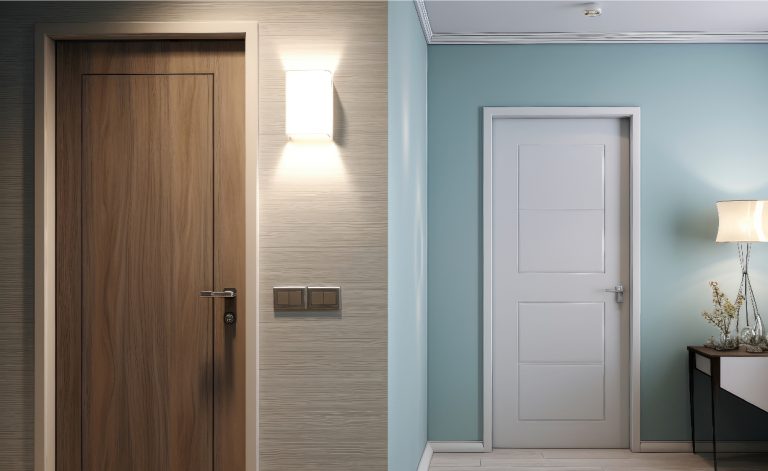Choosing the right door style is crucial when designing your home. Doors are not just functional elements but significant design statements that set the tone for your entire space. Whether you’re leaning toward a modern aesthetic or prefer the timeless charm of classic designs, getting the right fit for your home requires careful consideration. Below, we’ll break down the key differences between modern and classic door styles to help you make an informed choice.
Understanding Modern Door Styles
Sleek, minimalist designs characterize modern door styles. These doors often feature clean lines, smooth surfaces, and an emphasis on simplicity. They avoid excessive detailing, making them great for contemporary homes with open layouts and modern decor.
Key Features of Modern Doors
- Minimalist Design
Modern doors focus on simplicity. They typically have flat panels, monochromatic finishes, and no intricate embellishments. - Use of Materials
Materials such as metal, glass, and engineered wood are commonly used, giving modern doors a sleek and current look. - Bold Colors and Finishes
While neutrals are popular, bold blacks, whites, or statement colors can add a strikingly modern edge. - Functional Additions
Modern door trends often incorporate features like frosted glass panels or sliding mechanisms, offering an uncluttered yet practical aesthetic.
These doors are often seen in contemporary spaces, offering a sense of flow and simplicity that complements modern architecture.
Exploring Classic Door Styles
Classic door styles represent timeless elegance and attention to detail. Rooted in tradition, these doors usually feature intricate carvings, raised panels, and curved details that evoke sophistication and charm.
Key Features of Classic Doors
- Ornate Detailing
Unlike the flat panels of modern designs, classic doors often feature raised or recessed panels, decorative molding, and intricate carvings. - Rich Materials
Classic doors are made with traditional materials like solid hardwood, contributing to their durability and timeless appeal. - Elegant Finishes
Warm, natural wood tones or painted finishes in neutral shades such as white or beige add depth to these designs. - Complement Traditional Homes
Classic doors seamlessly coordinate with traditional decor styles, offering a refinement that never goes out of fashion.
These are ideal for a timeless, sophisticated look that aligns with vintage or historical design elements.
How to Decide the Best Door Style for Your Home
Choosing between modern and classic door styles can feel overwhelming, but the right pick should balance form, function, and how it harmonizes with your living space. Consider these factors when making your choice:
Consider Architectural Style
Start by assessing your home’s architectural style. Opt for modern doors to match the clean, streamlined aesthetic if it leans toward contemporary. On the other hand, classic doors work best in traditional homes, where their intricate detailing can shine.
Think About Interior Design
Your door style should complement your overall interior design choices. Homes with understated, modern furniture and open spaces pair well with modern doors. Classic doors offer a cohesive look for spaces filled with traditional furniture, rugs, and decor.
Functionality Matters
Don’t sacrifice functionality for looks. For instance, sliding doors or glass panels might make sense for a smaller, modern space as they can create the illusion of openness. Meanwhile, a sturdy, detailed classic door can enhance the privacy and richness of living areas in a traditional home.
Budget and Maintenance
Modern doors, especially those made with engineered materials, are often more affordable and require less maintenance. Classic doors, made from rich materials like hardwood, may have a higher price and demand more upkeep.
Enhance Curb Appeal
Your front door can set the tone for your home’s exterior. A sleek, modern door works for urban or minimalist homes, while a grand, classic door can make a traditional entryway truly stunning. For example, French doors in Salt Lake City offer a blend of style and functionality that fits beautifully with various design preferences.
Combining Modern and Classic Elements
It’s possible to blend modern and classic styles to suit transitional spaces. Consider a door with minimalist features but finished in a traditional material like oak or cherry wood. Alternatively, choose a classic panel design but have it painted in a bold, modern color. The key is balance, ensuring the elements complement rather than compete.
Conclusion
Selecting the right door style is ultimately about finding the perfect match for your home’s character and aesthetic. Start by evaluating what works best for your space, lifestyle, and budget. Whether you choose a clean-lined modern style or a detailed classic design, aim for a look that enhances your home’s overall appeal. With the right selection, your doors can become lasting features that exude beauty and functionality for years.
When selecting the perfect door style, consider the architectural nuances of your home. A modern door with sleek lines and minimalistic hardware can complement a contemporary setting, while a classic door with intricate details might enhance a traditional space. It’s essential to balance aesthetics with functionality, ensuring the door not only looks good but also serves its purpose effectively. For those seeking inspiration or guidance on choosing the right door style, exploring various options and expert advice can be invaluable. Read More to discover how different styles can transform your living space and make a lasting impression.

